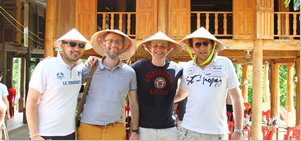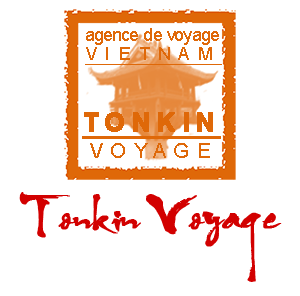Recognized as World Heritage site by UNESCO, peaceful Hoian ancient town is one of the most popular destinations in Vietnam satisfying travellers of all tastes and across the continents.
History and location
Hoian was a prosperous town on the sea routes of silk trade. The city was known to European navigators in Faifo, deformation from Hai Phố which means merchants from the seafront. Ships from all over Asia moored in the port of the city from the 10th century. Hoian experienced an expansion in the 15th century, wealthy merchants settled there countertops and built solid wooden houses. Strolling through this city is a real pleasure, all styles are found in Hoian: Chinese, Japanese, and even French have marked the architecture of this city a World Heritage Site by UNESCO. 844 buildings are listed for their architectural and historical interest.
The city is proud of its ancient and well-preserved typical Asian neighborhoods, unlike most Asian cities are racing to modernity. Some roofs are covered with thousands of concave and convex tiles, “Ying Yang” style. This symbol is also found on the doors of houses and protects its inhabitants. We list over 800 historic buildings including bridges, pagodas, temples, houses, communal house, graves, wells, etc.
As a port city 30km south of Danang, Hoian was called Faifo at the time of the first Western counters and was one of the most important ports of South Asia from the 17th to 19th centuries. At its peak, Hoian, contemporary Macao and Malacca, was a must stopover for Dutch, Portuguese, Chinese, Japanese merchant ships… Vietnamese boats lashed to Thailand, Indonesia and other regions of Vietnam. More than any other Vietnamese cities, Hoian retains the atmosphere of the past that invades you through your stay.
Things to discover
Japanese Covered Bridge
This covered bridge (Cầu Nhật Bản ở Lai Viễn Kiều) connects the 155 Tran Phu Street and 1 Nguyen Thi Minh Khai Street. The first bridge built in this location, in 1593, was at the initiative of the Japanese community of Hoian, eagered to link their neighborhood to that of the Chinese, on the other bank. The bridge has a roof to protect passers from the rain and sun. Both ends of the bridge are guarded by a pair of monkeys on one side and a pair of dogs on the other. According to one story, the bridge construction began in the year of the monkey and ended in the year of the dog. While access to the bridge, you will encounter an impressive temple built into the bridge’s northern side.
Built in the early 17th century, the bridge includes a harmony of architectural styles with Japanese, Vietnamese and Chinese cultures. More than 400 years have passed and the covered bridge remains a good shelter for passers against the rain and heat.
Tan Ky old house
A very old family house that was the home of a merchant from the early 19th century. During visit, tourists can be immersed in a place very special to meet three architectural influences: Chinese by the ideograms (Chinese poems in pearl adorning the columns that support the structure), Japanese for ceilings (rooftop lounge shaped crab shell, supported by three beams), and European by its balcony over the street.
The front of the house is a shop whose back faces the river suitable for exchanging goods. Inside, the house is decorated with precious wood materials very carefully carved and engraved in the shape of dragon or fruit. All this presents wealth of owners. Seven generations have lived here. According to a representative of the family, Tan Ky is a amongst the very few old houses that are the most intact and most beautiful in Vietnam.
Old house at 77 Tran Phu Street
This other private house, opposite the Restaurant 92 Tran Phu, is about 300 years. It was built in the early 18th century by a wealthy master, Quân Thắng, and remains almost intact thanks to the good care provided by the family. The house is very impressive with wood pieces covering the courtyard. All are finely carved, like beams and ceiling of the living room near the courtyard.
Quan Cong Temple
Built in the mid 17th century, the temple is dedicated to Quan Cong, a famous Chinese General who lived in the late second century AD. Praised by Chinese and Vietnamese community, it is the symbol of loyalty, honesty, integrity and justice. Constructed similarly to the shape of the Chinese letter “Quốc”, the majestic architectural style of the temple expresses philosophical and moral issues of human life. To the left of the temple, the statue of General Chau Xuong, one of Quan Cong’s guardians, takes a flattering pose. Rather plump Mandarin Quan Binh is on the right. A life-sized white horse recalls a mount ridden by Quan Cong. The names of generous donors therein on stone plates sealed in the walls. Carp-shaped objects can be found on the roof surrounding the courtyard. The carp is a symbol of patience in Chinese mythology and very popular in Hoian.
Skillful tailors
Hoian is the birthplace of the sewing machine and fabrics paradise. Fabrics of all kings, sometimes stacked to the ceiling, are available throughout the city. It’s an interesting experience to spend the morning in one of the shops and let yourself be pampered by the tailor. Choose from countless rolls of tissue the one that suits you and make new custom clothes for a pittance. However, the quality of the material and labor varies enormously from one shop to another. When buying silk, make sure to buy “Vietnamese silk” because there’s polyester or other synthetic fabrics that look like real silk. A surefire test is to apply a match or a cigarette on the fabric: synthetic melts, while silk burns. However, be careful not to fire the shop!
Museum of Sa Huynh Culture
Opened in 1995, the museum has 216 ancient objects found at archaeological excavations in Hoian area. All are approximately two thousand years old and were excavated in the villages of Hau Xa, Chiem Thanh, An Bang, Xuan Lam in the 1990s. Here are the most beautiful and unique collection of antiques of Sa Huynh culture in Hoian. The people of Sa Huynh would be the first owners of embryonic Hoian communicating with China, India and other countries in Southeast Asia.
Cua Dai Beach
Located 5km from Hoian ancient town, Cua Dai Beach is beautiful with all its fine white sand. This sandy beach (Bai Tam Cua Dai) is usually deserted, except full moon nights. It has changing rooms and sheltered kiosks selling refreshments. Open to the East Sea, the main route for foreign ships to enter Hoian Port. The path from Hoian to Cua Dai beach has a romantic beauty, typical landscape of Vietnam.
Place of interest
-
Northern Vietnam
- Where & When to visit the rice terraces in North Vietnam
- Huong Pagoda – Pilgrimage to the land of Buddhas
- Day Trips from Hanoi
- Things to do in Hanoi
- Hanoi, City of Peace
- Ninh Binh Province
- Bat Trang, ceramic art destination
- Duong Lam ancient village
- Tay Phuong Pagoda, the destination to calm down
- Cat Ba Island, World Biosphere Reserve
- Central Vietnam
- Southern Vietnam






